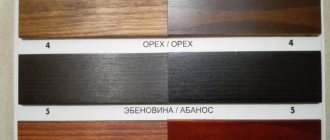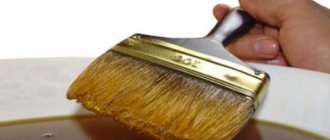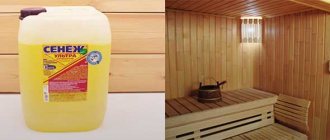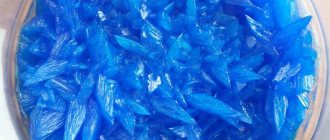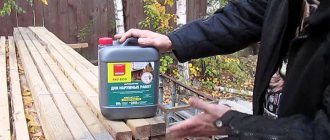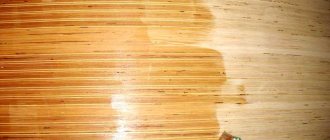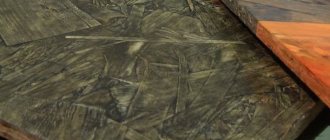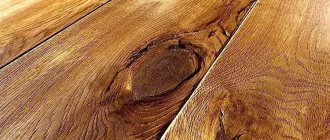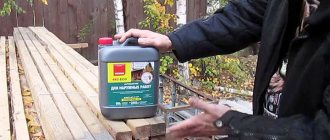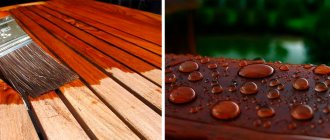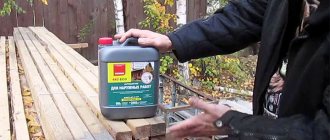Wood is soft but durable, a favorite material for many to build houses on summer cottages. Even if the building is built of brick or foam blocks, logs, beams or boards are used to build a bathhouse, garage, gazebo, veranda. You can’t do without wooden decor - a well, benches, swings, bridges. Fences and fences are also made of wood. To avoid rapid destruction of the material, effective protection of wood from external factors is necessary: excessive moisture, fire, insect pests.
- 2 Methods of protection against rotting
- 3 Fire retardants - reliable fire protection
- 4 Insects - no chance!
- 5 Comprehensive protection of residential buildings
Arguments for the need to protect material
Before treating wood to prevent it from rotting, you need to know the nuances that make the material illiquid. The main cause of rot is a fungus that tirelessly destroys wood. House fungus is considered the most insidious. It can destroy even treated surfaces.
To recognize the appearance of fungus, you need to pay attention to the following factors:
- softening the material;
- formation of microcracks;
- change in natural color;
- destruction of the original structure.
Excellent conditions for the emergence and spread of harmful fungus are:
- climatic conditions (freezing, constant exposure to moisture, precipitation, direct sunlight);
- direct contact with the ground.
With proper treatment of wood against rotting and moisture, its service life can be extended to three decades. Although, depending on the degree of influence of negative factors, this period can change both positively and negatively. You can protect a tree by various means. The most common is impregnation for wood against moisture and rot.
Antiseptics are produced based on chemical components. Their variety is great in the construction market. Each product has different properties, so you need to be savvy and choose the right ones for wood processing.
Damage to wood from moisture
Under natural conditions, a living tree has a number of protective mechanisms that prevent the negative effects of fungus, insects and rodents. Once cut, the wood becomes vulnerable. There is a loss of density and destruction of the structure.
The main enemy that accelerates these processes is moisture, which creates a favorable microclimate for the development of fungus. The following factors can provoke putrefactive processes (mold):
- condensation in the room;
- increased level of importance;
- temperature changes;
- freezing;
- contact with ground;
- precipitation.
Damage to wood can be prevented by treating its surfaces. This is done at the stage of wood storage or directly during construction. Impregnations with antiseptic properties are used as a working solution.
Types of wood protection products
When choosing liquids to protect wood from moisture and rotting, consumers pay attention to its high efficiency. But, in addition, the substance must not be harmful to human health. Most often, solutions that affect the durability of wood and can protect it from negative factors are quite dangerous.
It is absolutely necessary to ignore compounds containing tin and zinc compounds. These are the most toxic chemicals. Let's take a closer look at how to treat wood to protect it.
Decorative impregnation
Protecting wood from rot and water is the main task of moisture-resistant impregnation. The material processed with this composition is used to build baths, fences, basements, gazebos, etc. They are used both individually and in combination with bioprimers. The last substance must be treated with the boards before painting.
The essence of impregnation lies in its deep penetration into the structure of the wood and in this way clogging its pores. When treating wood with a solution, the penetration of moisture into the wood structure is limited. But besides this, impregnation colors wooden products and in this way gives them a noble appearance.
Decorative impregnation to protect wood from rotting and water penetrates too slowly into the wood. It can also be noted that the price for it is considerable.
Oil based product
To prevent rotting, covering the boards with an oil-based product is necessary when using them externally. Protection of the board from rotting is ensured by the film formed after applying the product to the surface. Moreover, the resulting film on wood soaked in the solution does not allow water to be absorbed, and, therefore, prevents the fungus from penetrating into the wood structure.
The disadvantage of this product is the fact that a film forms on the surface, and it is not capable of protecting the tree from the effects of the fungus that already lives inside. The liquid composition of the impregnation is almost non-toxic, so it is used to cover wooden elements in houses where people live.
Water-based impregnation
Also, to protect wood from moisture, impregnation is used, which is well diluted in water. It is absolutely safe, there is no pungent odor when working with it, and it dries quickly. Water-soluble impregnations are used to prevent wood rotting and fungal penetration. Despite this, this composition is not recommended for use in rooms with high humidity. For example, when building a bathhouse, sauna or cellar.
The components of such solutions are boric acid, zinc chloride and sodium fluoride. They are better suited for wood, which is used in making furniture, making door openings, window slopes or frames.
Volatile based product
You can treat wood against rotting using means that have an easily volatile substance. The production of compositions is based on the addition of a certain substance to the coloring compositions, such as a solvent. Products of this type are not able to penetrate deeply into the structure of the wood, but at the same time they create a film whose strength is quite high.
Due to its volatility, the composition is best used for outdoor work, but it can also be used for interior wood processing indoors. The disadvantages of volatile agents include the long drying time of impregnating materials.
Protective clothing for working with antiseptics
Before treating wood to remove moisture, you should take precautions. When working with volatile impregnations, you must wear a protective mask or respirator.
Goggles, closed type, flexible, chemical resistant
Respirator RPG-67 with FFP3 filters
Rubber gloves MBS KShchS solutions up to 80% gaiter
Famous manufacturers
Below is a list of manufacturing companies whose products are in greatest demand.
Belinka
Country of origin: Slovenia.
Engaged in the production of impregnations for the protection and decoration of wood. This:
- transparent antiseptics;
- penetrating primers;
- azure multilayer impregnation with the addition of wax;
- azure decorative impregnations;
- paints.
Belinka has official representative offices throughout Russia.
Aquatex
A Russian company that produces several types of combined impregnation compositions:
- “Aquatex Extra” - based on wax, oil;
- “Aquatex primer antiseptic” is a non-washable antiseptic;
- "Aquatex" - decorative with bioprotection and others.
Each contains an ultraviolet filter.
Aquatex does not produce products with biopyrene protection.
Tikkurila
The Finnish concern produces many series of paint and varnish products. Products with antiseptic protection, against insects, ultraviolet radiation. They have an environmentally friendly composition. Some antiseptics can be tinted.
Senezh
Russian trademark.
Specialization - production of impregnations for processing wood and decking boards.
The list of products includes:
- biopyrenes;
- preservative solutions;
- antiseptics;
- decorative;
- protective compounds.
There are tinted solutions. The price is affordable.
NEOMID
Russian manufacturing company.
The products are considered one of the best on our market for protecting wood and decking boards from fire and moisture.
On average, antiseptic protection lasts 10 years, and against fire – 7 years.
To control the quality of processing, a tinting pigment is included.
Can be used in residential buildings, bathhouses, gazebos, summer kitchens.
How to protect a tree with improvised means
You can protect a tree not only with modern methods. Since ancient times, recipes have come to us on how to protect wood from rotting using improvised means. Treating wood against rotting using traditional methods also allows for fairly high-quality protection of the material. Many effective options have reached our times:
- Coating wooden structures with carpentry (silicate) glue, which is used to impregnate boards and other materials.
- Pre-treatment of parts of the house going into the ground and the soil itself with a solution of potassium dichromate with sulfuric acid. The proportions are one to one.
- You can treat with a solution of vinegar and soda. It is more convenient to carry out the work using a sprayer.
- Copper sulfate protects boards very well from moisture and rotting. The best option is to use a 1% solution.
- The most ancient and effective way to protect wood from moisture and rot is resin. It is heated and coated with elements of wooden structures that most often come into contact with the ground.
- They are also treated with a solution, which is obtained by mixing boric acid, salt and water in the ratio: per 10 liters of water, 1 part boric acid and 20 parts salt. Treatment with this solution is carried out several times.
Important! It should be remembered that all of the folk remedies listed above can be used to treat wood that has not yet been infected.
On video: how to protect a wooden house from rotting, moisture and fire.
Sawn timber
Sawn timber is produced by removing the bark and top layer using a special machine. This material has an equal cross-section, its dimensions can be 10 by 10 cm, 12 by 12 cm, 20 by 20 cm, etc. Using sawn timber to build a small country house is an excellent option. Despite the fact that sawn timber is a budget and most affordable material, building a house from it will still not be cheap. If you plan to purchase this material for the construction of large residential buildings, cottages, then you should know that it will be necessary to additionally carry out insulation and finishing work inside and outside the premises. Over time, sawn timber may become deformed; to prevent this, reliable fasteners should be used along its entire length.
Modern methods of combating wood rot
Protection from moisture using modern methods is carried out in two ways: the preservation process and treatment with antiseptics. With the method of preserving wood material, the process lasts quite a long time. During its course, the solution impregnates and etches the affected areas. In this case, the board is placed in a container with a solution and soaked for a certain time.
You can carry out diffusion or autoclave impregnation, which is carried out only in factory conditions.
Antiseptic impregnation involves a treatment that is performed by applying a special substance to wood. To do this, use a paint brush, roller or sprayer. Before soaking, the board is prepared. In accordance with the intended purpose, impregnation is used that is suitable for this function.
For example, white spirit is quite easily removed from the surface, so it is not recommended to use it in rooms where there is a high degree of humidity or dampness. The question arises - how to protect the wood in this case? Water-repellent products are best.
What is the danger of rot?
The most obvious answer is that the structure of the wood is destroyed, delaminates, and falls into pieces in the shortest possible time. Elements of the porch, fence, and building will have to be changed. The consequence is moral discomfort, an unfavorable indoor microclimate, and additional costs for repair work.
The main reason that forces a person to fight mold and rot on wood is the spread of numerous respiratory diseases, including asthma. It is easier to eliminate putrefactive stains than to spend years on treatment.
Processing rules
Processing boards with impregnation does not cause any particular difficulties. However, there are several rules that must be strictly followed to achieve the desired result and maintain your own health:
- It is imperative to protect all vulnerable areas of the human body that will be in direct contact with the solution (hands: eyes, respiratory organs).
- Before processing wood to prevent it from rotting, it is necessary to prepare it for work: clean it of dust, grease or previously applied paint.
- The board is carefully processed using a brush with metal bristles.
- It is best to wash the surface using detergents.
- It is equally important to let the wood dry thoroughly.
- Before impregnating the wood, carefully read the instructions for its use on the packaging.
- It is recommended to start with the end parts of the board, cuts and areas that are already damaged.
- If there is a need to apply the product in several layers, it is necessary to allow time for the previous layer to dry completely. Typically this period of time is 2–3 hours.
We increase fire resistance
Protecting wood from moisture and rot is not the entire range of work that must be performed before use. One of the weak points of wooden structures is their rapid flammability. Therefore, we pay attention to solutions that can slightly increase the degree of fire resistance of wood, the so-called fire retardants. This is especially true in residential buildings.
The essence of fire retardants is that under the influence of high temperature they form a film that can delay the ignition of wood material for some time.
With the help of additional treatments against the influence of all negative factors, the reliability of a wooden structure can be significantly increased. The best treatment is up to consumers to decide depending on individual preferences and conditions.
